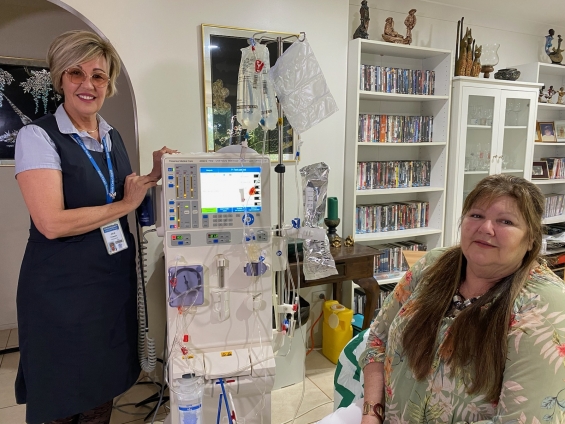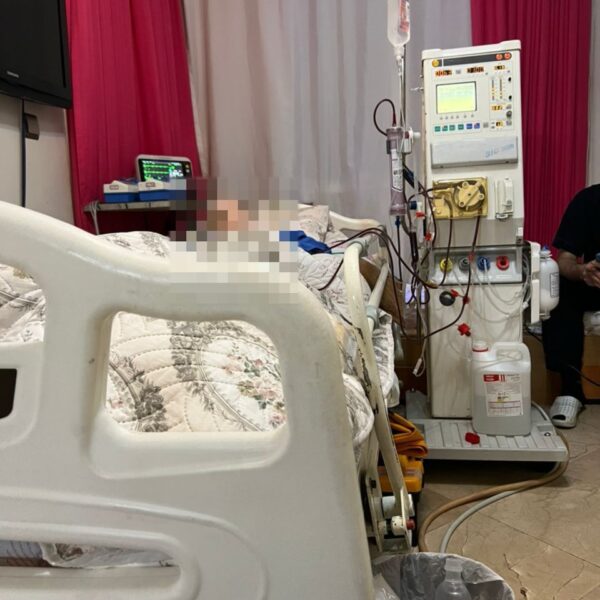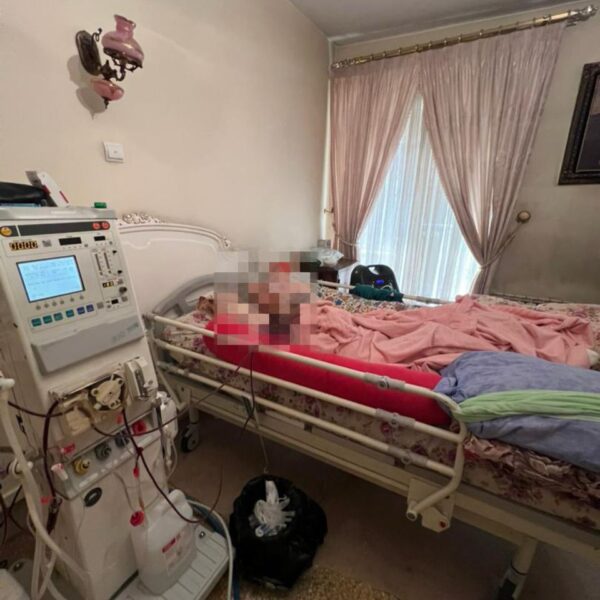Home dialysis
Home dialysis: The best alternative to dialysis centers
Home dialysis is a new and safe method for kidney patients who require hemodialysis or peritoneal dialysis . Using advanced equipment and experienced medical staff, this method allows for the possibility of receiving quality treatment in the peaceful environment of the home.
If you or a loved one needs dialysis due to kidney failure, home dialysis services in Tehran are the best choice for you.
Dialysis is a treatment that removes waste products and excess water from the blood. A person undergoes dialysis based on their clinical condition, test results (such as creatinine concentration, potassium ions, eGFR value), and a doctor’s recommendation.
In these circumstances, the Shafakala Yekta specialist team provides home dialysis services, because going to medical centers for dialysis may be difficult for the individual. Also, performing dialysis at home keeps you safe from pollution and diseases in the centers, and you avoid traffic, wasting time, commuting, and many other things.
For home dialysis, a dialysis machine is required, which is provided by Shafakala Yekta agents. In addition, a medical water purification system will be installed in your home.
Why Shafakala Yekta Company for home dialysis?
Officially licensed by the Ministry of Health
Experienced staff with 10 years of experience in home dialysis
Direct contract with all basic and supplementary insurances
Submitting a weekly report to the treating physician
Hemodialysis and home dialysis services in Tehran
Today, with the advancement of technology and the increasing need of kidney patients for quality medical services, home dialysis has become one of the best options. If you or your loved ones need hemodialysis (blood dialysis) or peritoneal dialysis, we provide specialized and quality services in all parts of Tehran.
Coverage in all areas of Tehran:
From north to south, east to west of Tehran, our expert staff is ready to provide the best quality services.

Contact number: 02122305007
Emergency dialysis at home: The best home dialysis center in Tehran
If you or your loved ones need emergency dialysis at home , we, with our expert and experienced team, are ready to provide hemodialysis and peritoneal dialysis services as quickly as possible in all parts of Tehran.
Why choose emergency home dialysis?




Our services include:




Benefits of home dialysis
Planning for physical activity
Balancing dialysis time with studying or work
Thanks to modern technology, blood purification is easy and effective.
It saves patients from the stress of traveling to medical centers.
Thanks to the ability to adjust the timing of dialysis, the patient can freely enjoy life.
You are completely free in the days between dialysis treatments and don’t have to worry about doing it.
Peritoneal dialysis does not require a restrictive diet like hemodialysis, which is performed in a hospital.
Home dialysis gives patients a sense of independence, improves quality of life, and reduces feelings of fatigue.

Home hemodialysis
Home hemodialysis When you are told that you have kidney failure and need treatment to survive, it can be a difficult and challenging time in your life. You may have many worries. These worries can be physical, emotional and financial. If your kidney disease diagnosis is new, you may feel tired, confused and angry. You may be worried about how kidney failure and dialysis will change your future and quality of life. But there are important things you can do to help yourself. Learn all you can about your treatment options. Take an active role in making decisions about your care. Kidney failure can be treated with hemodialysis, peritoneal dialysis or a kidney transplant. Exploring the advantages and disadvantages of each of these options can help you and your healthcare professional decide what is best for you. This leaflet is about a specific type of hemodialysis –
Advantages and disadvantages of home hemodialysis
Advantages and Disadvantages of Home Hemodialysis There are different ways to schedule home hemodialysis treatments. All have important advantages and disadvantages compared to in-center hemodialysis. Advantages: • Easier to fit into your daily schedule • Easier to continue if you have a job or want to return to work or school • No need to travel to the dialysis center three times a week • Independence and control over your treatments • Likelihood of better health outcomes over time • Comfort and privacy of being in your own home during treatment • Access to your phone, family members, and visitors during treatment • Ability to eat and drink if you wish during treatment • Your access may be longer. Disadvantages: Initial fear about the tasks and care of the dialysis machine • Home hemodialysis training is not provided by all dialysis centers • More space is needed in your home for equipment and supplies • A care partner is generally needed to be with you during treatment Some plumbing and wiring changes in your home may be necessary. But newer machines use standard household outlets • Electricity, gas and water bills may increase slightly • Some new machines are portable, but you will need to find a dialysis center for support when traveling • Less social interaction compared to going to a dialysis center • Your care partner may get tired of this role.

Different home hemodialysis programs
You can do hemodialysis at home using one of three types of programs. Regardless of which program you choose, you and your care partner are trained to perform dialysis safely and address any problems that may arise. Each program is different, and the training time varies from person to person, but it usually takes three to eight weeks. 1. Regular home hemodialysis: You have hemodialysis three times a week for three to four hours or more. 2. Short daily home hemodialysis: This program calls for hemodialysis five to seven times a week using machines designed for short-term, daily treatment at home. Treatments usually last about two hours. As you receive more dialysis, less fluid needs to be removed from your blood each time. This reduces recovery symptoms such as headaches, nausea, muscle cramps, and a “flushing” feeling after treatment. Some centers monitor your treatments by sending information from your dialysis machine via a telephone modem or the Internet. More hours of dialysis per week can increase the removal of waste products from your blood. As a result, many patients report improvements such as those listed on the next page.
Signs of need for dialysis
Symptoms of kidney failure include the following:
- Decreased urination
- Due to the inability to urinate, fluid retention in the body causes swelling of the lower limbs, legs, and knees.
- Puffiness under the eyes
- Fatigue and weakness
- Confusion
- Nausea
- Shortness of breath and chest pain
- Arrhythmia or irregular heartbeat
- Decreased intelligence
- Persistent itching
- Cramps and sudden muscle contractions
- Seizure
- In severe cases, kidney failure can cause coma and, in some cases, death.
What should be done before, during and after dialysis at home?
Home dialysis is a method of purifying blood at home that allows patients with kidney failure to receive their treatment without having to go to a medical center. To have a successful and safe dialysis at home, it is very important to follow some tips before, during, and after dialysis.
Before dialysis
- Preparing the dialysis site: The dialysis site should be clean, dry, and free of any contamination.
- Equipment preparation: Make sure all dialysis equipment (machine, tubing, dialysis solution, etc.) is available and ready to use.
- Check the condition of the fistula or catheter: Check the needle insertion site (fistula or catheter) for redness, swelling, or pain.
- Blood pressure measurement: Measure your blood pressure before starting dialysis.
- Diet: A proper diet before dialysis helps improve treatment outcomes.
During dialysis
- Monitoring the dialysis machine: Check the dialysis machine regularly to make sure it is working properly.
- Check your vital signs: Measure your blood pressure, heart rate, and body temperature regularly.
- Calm and rest: Try to stay calm and rest during dialysis.
- Record information: Record information about each dialysis session (such as start and end times, blood pressure, amount of fluid removed, etc.) in a special notebook.
After dialysis
- Care of the needle insertion site: Wash the needle insertion site with soap and water and bandage it.
- Cleaning equipment: Clean dialysis equipment according to instructions.
- Diet: Pay attention to your diet and avoid consuming prohibited foods.
- Get enough rest: Get enough rest after dialysis.
Home dialysis: Reducing stress, increasing comfort
In home dialysis services, advanced medical techniques and up-to-date equipment are used to ensure that the dialysis process is performed correctly and effectively. The equipment used includes portable dialysis machines, continuous monitoring systems, and standard consumables, all of which are carefully calibrated to provide the highest level of accuracy and efficiency. The experienced medical team , which includes nephrologists, specialist nurses, and professional technicians, ensures close monitoring and continuous care for patients. Shafakala Company, by utilizing the latest technologies and the most experienced medical staff, guarantees the high quality of its services and frees patients from any concerns about the quality and efficiency of the services.
One of the most important advantages of home dialysis is the reduction in the need to transport the patient to medical centers, which is especially important for elderly patients with limited mobility. This method is not only physically more economical but also economically more economical, as the costs associated with transportation and hospitalization are reduced. Also, by performing dialysis in the familiar and comfortable environment of home, patients feel more relaxed and can continue their daily activities. Shafakala Company strives to provide the necessary facilities so that patients can benefit from these benefits and have a more comfortable life.
Using Shafakala’s home dialysis services not only helps improve the quality of life of patients, but also has many economic and psychological benefits. By choosing these services, patients can benefit from the most advanced equipment and the best care and continue their daily lives with more peace of mind. We invite you to trust Shafakala, benefit from our unique services and experience a different experience of home medical care.
The main equipment needed for home dialysis is:
- Dialysis machine: The beating heart of the system. This machine takes blood from the patient’s body, removes waste products and excess fluids, and then returns the cleaned blood to the body. Home dialysis machines are usually smaller and more portable than those used in dialysis centers.
- Dialysis filter (dialyzer): This filter contains semi-permeable membranes that allow waste products and fluids to pass through but not blood cells. Dialysis filters are replaced regularly.
- Blood and dialysis tubes: These tubes are used to connect the patient to the dialysis machine and blood transfusion. These tubes are usually made of biocompatible materials to prevent allergic reactions.
- Dialysis solution: This solution contains minerals, electrolytes, and other substances needed to maintain the body’s chemical balance. Dialysis solution flows continuously during the dialysis process.
- Dialysis console: This console is used to monitor blood flow, pressure, and other dialysis parameters. The console also has a screen that displays important information about the dialysis process.
- Scale: Used to measure the patient’s weight before and after dialysis. Changes in weight can indicate the amount of fluid that has been removed from the patient’s body.
- Blood pressure monitor: Used to measure a patient’s blood pressure before, during, and after dialysis. High blood pressure is a common complication of kidney disease and it is very important to control it.
- Disinfectants: Used to maintain hygiene and prevent infection. All equipment and surfaces that come into contact with the patient’s blood should be disinfected regularly.
General steps for doing dialysis at home
Environment preparation:
- Suitable location: The place in the home designated for dialysis should be clean, quiet, and free of any contamination.
- Equipment: All dialysis equipment, such as the dialysis machine, filter, tubing, dialysis solution, and console, must be properly set up and ready to use.
Patient preparation:
- Vascular access: The patient must have vascular access (such as a fistula or graft) that will be used to connect to the dialysis machine.
- Weight and blood pressure: Before dialysis begins, the patient’s weight is measured and their blood pressure is monitored.
Connecting to the device:
- Dialysis tubes: Dialysis tubes are connected to the patient’s vascular access.
- Pump Start: The dialysis machine begins pumping blood and passing it through the dialysis filter.
Blood filtration:
- Waste removal: In the dialysis filter, waste products, excess fluids, and some minerals are removed from the blood and replaced with dialysis solution.
- Metabolism: This process helps restore the body’s chemical balance.
End of dialysis:
- Disconnection: After the dialysis time is over, the dialysis tubes are disconnected from the patient’s body.
- Cleaning: Dialysis equipment is carefully cleaned and disinfected.
Post-dialysis care:
- Patient monitoring: The patient is monitored for a short period of time after dialysis to ensure that there are no complications.
- Data recording: Dialysis-related information such as blood pressure, weight, and the amount of fluid removed is recorded.
Cost of home dialysis
The cost of home dialysis depends on a variety of factors, and there is no one fixed figure for all patients. Some of the factors that affect the cost of home dialysis include:
- Type of dialysis: Hemodialysis and peritoneal dialysis are the two main types of dialysis that have different costs.
- Dialysis frequency: The number of dialysis sessions per week affects costs.
- Type of equipment: The type of dialysis machine, filters, and solutions used in dialysis also affect costs.
- Additional services: Services such as patient education, home nursing care, and equipment transportation costs also add to the costs.







